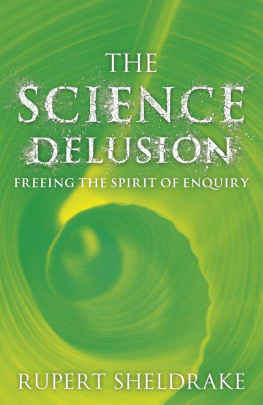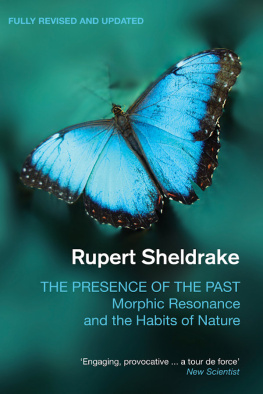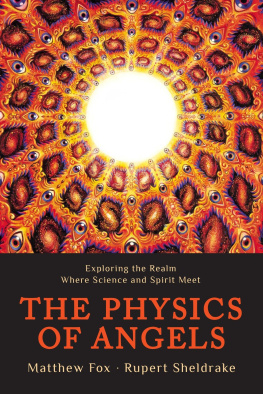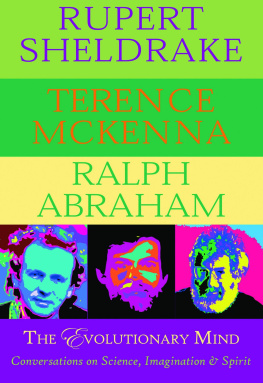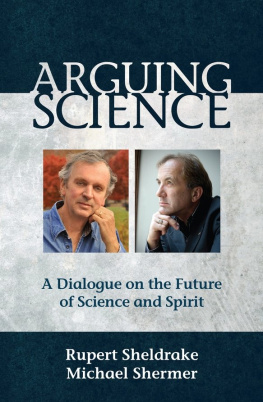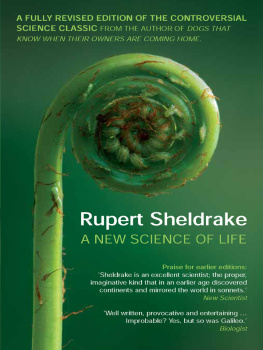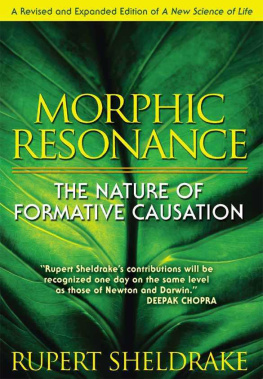Also by Rupert Sheldrake
A New Science of Life ( 1981 ; new edition 2009 )
The Presence of the Past ( 1988 ; new edition 2011 )
The Rebirth of Nature ( 1990 )
Seven Experiments That Could Change the World ( 1994 ; new edition 2002 )
Dogs That Know When Their Owners Are Coming Home ( 1999 ; new edition 2011 )
The Sense of Being Stared At ( 2003 )
with Ralph Abraham and Terence McKenna
Chaos Creativity and Cosmic Consciousness ( 2001 )
The Evolutionary Mind ( 2005 )
with Matthew Fox
Natural Grace ( 1996 )
The Physics of Angels ( 1996 )
The Science Delusion
Freeing the Spirit of Enquiry
Rupert Sheldrake

www.hodder.co.uk
First published in Great Britain in 2012 by Coronet
An imprint of Hodder & Stoughton
An Hachette UK company
Copyright Rupert Sheldrake 2012
The right of Rupert Sheldrake to be identified as the Author of the
Work has been asserted by him in accordance with the Copyright,
Designs and Patents Act 1988.
All rights reserved. No part of this publication may be reproduced,
stored in a retrieval system, or transmitted, in any form or by any
means without the prior written permission of the publisher, nor be
otherwise circulated in any form of binding or cover other than that
in which it is published and without a similar condition being
imposed on the subsequent purchaser.
A CIP catalogue record for this title is available from the British Library
ISBN 978 1 444 72795 1
Hodder & Stoughton Ltd
338 Euston Road
London NW1 3BH
www.hodder.co.uk
For all those who have helped and encouraged me, especially my wife Jill and our sons Merlin and Cosmo.
Contents
Preface
My interest in science began when I was very young. As a child I kept many kinds of animals, ranging from caterpillars and tadpoles to pigeons, rabbits, tortoises and a dog. My father, a herbalist, pharmacist and microscopist, taught me about plants from my earliest years. He showed me a world of wonders through his microscope, including tiny creatures in drops of pond water, scales on butterflies wings, shells of diatoms, cross-sections of plant stems and a sample of radium that glowed in the dark. I collected plants and read books on natural history, like Fabres Book of Insects , which told the life stories of scarab beetles, praying mantises and glow-worms. By the time I was twelve years old I wanted to become a biologist.
I studied sciences at school and then at Cambridge University, where I majored in biochemistry. I liked what I was doing, but found the focus very narrow, and wanted to see a bigger picture. I had a life-changing opportunity to widen my perspective when I was awarded a Frank Knox fellowship in the graduate school at Harvard, where I studied the history and philosophy of science.
I returned to Cambridge to do research on the development of plants. In the course of my PhD project, I made an original discovery: dying cells play a major part in the regulation of plant growth, releasing the plant hormone auxin as they break down in the process of programmed cell death. Inside growing plants, new wood cells dissolve themselves as they die, leaving their cellulose walls as microscopic tubes through which water is conducted in stems, roots and veins of leaves. I discovered that auxin is produced as cells die, that dying cells stimulate more growth; more growth leads to more death, and hence to more growth.
After receiving my PhD, I was elected to a research fellowship of Clare College, Cambridge, where I was director of studies in cell biology and biochemistry, teaching students in tutorials and lab classes. I was then appointed a research fellow of the Royal Society and continued my research at Cambridge on plant hormones, studying the way in which auxin is transported from the shoots towards the root tips. With my colleague Philip Rubery, I worked out the molecular basis of polar auxin transport, providing a foundation on which much subsequent research on plant polarity has been built.
Funded by the Royal Society, I spent a year at the University of Malaya, studying rain forest ferns, and at the Rubber Research Institute of Malaya I discovered how the flow of latex in rubber trees is regulated genetically, and I shed new light on the development of latex vessels.
When I returned to Cambridge, I developed a new hypothesis of ageing in plants and animals, including humans. All cells age. When they stop growing, they eventually die. My hypothesis is about rejuvenation, and proposes that harmful waste products build up in all cells, causing them to age, but they can produce rejuvenated daughter cells by asymmetric cell divisions in which one cell receives most of these waste products and is doomed, while the other is wiped clean. The most rejuvenated of all cells are eggs. In both plants and animals, two successive cell divisions (meiosis) produce an egg cell and three sister cells, which quickly die. My hypothesis was published in Nature in 1974 in a paper called The ageing, growth and death of cells. Programmed cell death, or apoptosis, has since become a major field of research, important for our understanding of diseases such as cancer and HIV, as well as tissue regeneration through stem cells. Many stem cells divide asymmetrically, producing a new, rejuvenated stem cell and a cell that differentiates, ages and dies. My hypothesis is that the rejuvenation of stem cells through cell division depends on their sisters paying the price of mortality.
Wanting to broaden my horizons and do practical research that could benefit some of the worlds poorest people, I left Cambridge to join the International Crops Research Institute for the Semi-Arid Tropics, near Hyderabad, India, as Principal Plant Physiologist, working on chickpeas and pigeonpeas. that are now widely used by farmers in Asia and Africa, greatly increasing yields.
A new phase in my scientific career began in 1981 with the publication of my book A New Science of Life , in which I suggested a hypothesis of form-shaping fields, called morphogenetic fields, that control the development of animal embryos and the growth of plants. I proposed that these fields have an inherent memory, given by a process called morphic resonance. This hypothesis was supported by the available evidence and gave rise to a range of experimental tests, summarised in the new edition of A New Science of Life ( 2009 ).
After my return to England from India, I continued to investigate plant development, and also started research with homing pigeons, which had intrigued me since I kept pigeons as a child. How do pigeons find their way home from hundreds of miles away, across unfamiliar terrain and even across the sea? I thought they might be linked to their home by a field that acted like an invisible elastic band, pulling them homewards. Even if they have a magnetic sense as well, they cannot find their home just by knowing compass directions. If you were parachuted into unknown territory with a compass, you would know where north was, but not where your home was.
I came to realise that pigeon navigation was just one of many unexplained powers of animals. Another was the ability of some dogs to know when their owners are coming home, seemingly telepathically. It was not difficult or expensive to do research on these subjects, and the results were fascinating. In 1994 I published a book called Seven Experiments that Could Change the World in which I proposed low-cost tests that could change our ideas about the nature of reality, with results that were summarised in a new edition ( 2002 ), and in my books Dogs That Know When Their Owners Are Coming Home ( 1999 ; new edition 2011 ) and The Sense of Being Stared At ( 2003 ).
Next page
